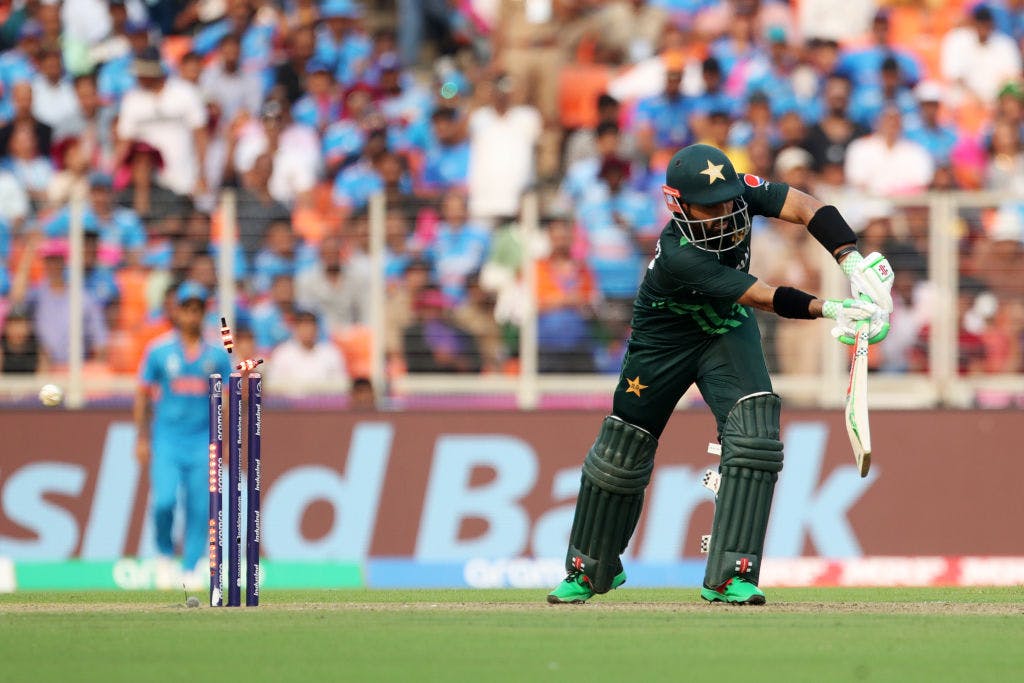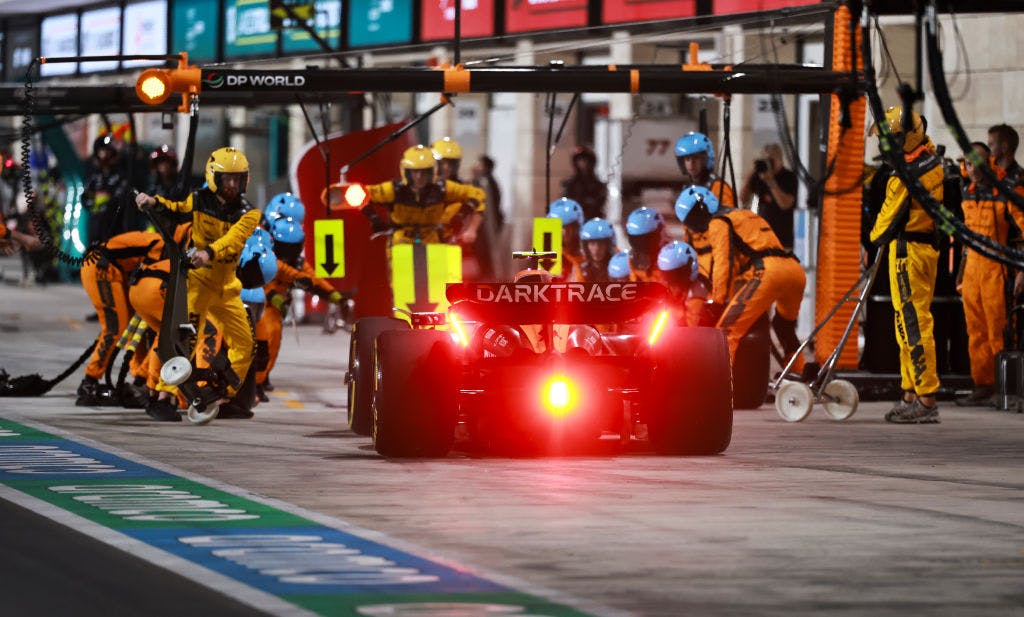
- Vertical feeds rolled out on digital platforms by Disney Star and Sky Deutschland, among others
- Distribution in 9:16 and other vertical aspect ratios brings monetisation challenges
- Sanjog Gupta, Barney Francis and Alessandro Reitano speak to SportBusiness Media
Sport still makes most of its money through people watching it on horizontal screens. But consumption habits are changing. Video, including of sport, is increasingly consumed on phones – and vertically.
Which is why, on October 8, two major sports events were shown in a vertical format. Media group Disney Star offered its mobile viewers in India a vertical feed of the India vs Australia match from the ICC Cricket World Cup, as it is doing for all 48 matches over the tournament.
On the same day, German pay-television broadcaster Sky Deutschland showed the Qatar Grand Prix on its TikTok account in a vertical format.
The broadcasters are in experimental mode, as Sanjog Gupta, Disney Star’s head of sports, told SportBusiness Media:
“Sport, and the experience that we’re delivering fans, has to keep pace with the consumption shifts underway – in fact, stay one step ahead of them, if possible. So, one, we have to constantly look at what the viewer is consuming, and thus being habituated to consume, and two, at what’s possible for us to shape as an experience that could either engage current fans more deeply or bring in new fans.”
The data shows this is necessary. A report from Nielsen and LaLiga Tech last year, which surveyed 20,000 people, found that nearly half (46%) of younger fans (under 34) expressed a preference for watching sport on smartphones or tablets.
But the migration to a 9:16 aspect ratio or something similar is far from straightforward, and, perhaps most pertinently, questions remain over how the format can be monetised at scale.
Barney Francis, executive vice president, global production at IMG, told SportBusiness Media: “The monetization of the small screen needs to get more sophisticated, as that’s where federations have seen significant leakage of revenue, largely through social media platforms.”
There are also questions over the optimal form of production for vertical feeds, particularly on whether to use dedicated cameras or crop from the primary 16:9 feed.
“This is a super early stage,” Alessandro Reitano, senior vice president sports production at Sky Deutschland, told SportBusiness Media.
“The strategy is not quite clear at the moment: it is about testing, as the learning curve is high. We’re seeing if we can engage a different audience with this tool. Is it really successful in attracting the TikTok generation? Are they really interested in watching the whole live event in 9:16 as the main feed? We’re trying a couple of cases.”
Precedent
Germany has proved something of testing ground for the vertical format.
The German Football League (DFL) was the first rights-holder to test a 9:16 format designed particularly for smartphones and social media dissemination. It was first trialled during the Bundesliga match between VfL Wolfsburg and Werder Bremen in late 2019.
Sportcast, the league’s host broadcast subsidiary, then produced the 2021 DFL Supercup in a vertical format with nine cameras and a separate directorial team. It was streamed live by domestic commercial broadcaster Sat.1 via its ‘ransport’ TikTok account and by media platform OneFootball in Brazil on TikTok as well.
This summer, Sky Deutschland, working with production firm Vizrt, broadcast the DFL Supercup live, again on TikTok in a vertical format, in an attempt to broaden the reach of the standard audience for the annual match.
Meanwhile, last month SailGP, the annual sailing series, streamed its first event live on TikTok, with a reporter onboard each F50 catamaran to capture the footage.
And now the ongoing Cricket World Cup, which started on October 5 and will conclude on November 19, is the first major global tournament to offer a vertical feed for all matches. ICC TV, supported by Disney Star, is producing an additional vertical video feed alongside its standard feed, that it has said will “revolutionize fans’ viewing experience.”
Gupta acknowledged that live sport is still “best consumed on screens that deliver a more immersive, lean-back and communal viewing experience,” but added that their research had shown increased vertical take-up. “In the absence of access to those [horizontal] screens, we are now seeing longer, more frequent engagement sessions on the smaller screen.”

Cameras
For the World Cup, the ICC and Disney Star are using dedicated, vertically-oriented cameras, alongside their standard cameras for the world feed. The latter is also offered on its vertical-feed service, through split screens which also offer other content such as match stats.
The decision to use dedicated cameras was to enhance the user experience. “We were using an AI-based solution to recraft what was produced for the world feed,” Gupta told SportBusiness Media. “But we don’t believe that the experience is necessarily the best. It doesn’t take advantage of the differentiated utility the screen offers, and isn’t aligned to signals of differentiated consumption patterns. That’s why we’ve deployed six additional cameras, at every venue, and an independent end-to-end production workflow for every match.”
This has been a significant logistical challenge, given there are ten venues. Gupta said, though, that the bigger challenge was the design of the feed. “The first question for us to solve was that different mobile screens tend to be of different sizes. So how do you design an experience, which is vertical, such that it doesn’t lead to dissonance on any screen? The feed that we’re producing is actually not 9:16, it’s 9:14. Because that was the only way we could serve so many different mobile screens.”
Gupta added: “We relied heavily on insights gleaned from eye-tracking studies that have been done to understand viewership on a six-inch screen. Where does your eye typically focus, and what do you consume on the top part of the screen versus the bottom? A lot of our graphics had to be redone entirely, because the way that you look at a mobile screen, especially when it’s in the vertical mode, is very different from the way that you look at a typical big screen.”
Given the increase to host broadcast costs, is it necessary to use dedicated cameras? “From my point of view, you have think about it case-by-case if it’s really necessary to use dedicated cameras,” Reitano said, speaking about Sky Deutschland’s use of a cropped feed.
“We’ve discussed this with TikTok, with Instagram, and others: on the vertical screen, how much needs to be going on? What we’re hearing is, the more we can engage with different sources, with different stories, the better. So, for instance, for Formula 1 we have a dedicated profile of the teams available to view on screen at the same time as the race is on. This is what we are trying at the moment: to configure something which is new in the market.”
Some sports more suited?
For Francis, “different sports have different challenges. Some sports lend themselves more to the format than others.”
F1 works well, in his view. “You tend to watch cars coming towards the camera, and because they go so fast, you don’t need that left-right movement. Tennis would also work well, though doubles less so. For golf, you’d have the shot from the tee, and then a shot of where the ball has landed. However, you do also need that establishing shot, to get a sense of the position, which is where a data underlay is so important.”
Referring to Disney Star’s coverage of the Cricket World Cup, Francis said: “It’s great they’re doing that – a batsman hitting the ball lends itself well to 9:16. That is the traditional ‘Camera 1’ view, offering the point of delivery and the batsman striking the ball.”
However, he added that, “The problem comes in after the ball has been hit and you have to go to ‘Camera 2’ or ‘4’, depending on where it’s been struck. So, for seeing a batsman’s technique, 9:16 or 9:14 is perfect; the challenge comes in telling the wider story of that particular ball.”
There can be a marked difference in direction, as Gupta said: “The cameras and replays are deployed in a way where you see more of the athlete, more of their core skills and are deeper into moments of the game.”
Cricket is the number one sport in India, but does a vertical format work for football, the number one sport globally?
“Football lends itself more to 16:9,” Francis told SportBusiness Media. “Width is essential to follow the flow of the game, where a defender might hit it 40 yards.”
For Gupta, the imperative is for all sports to adapt to the formats which consumers are using. He said: “Any sport which wants to continue to stay relevant for the next two, three, four decades, has to continually look at new ways of recruiting and engaging fans.”

Engagement
One way of doing this has been to supplement the vertical feed with the use of influencers. Reitano outlines their strategy: “You have to pick the right influencers, which engages in a different way with different audience groups.” For the Qatar Grand Prix, Sky Deutschland used Formula 3 driver Sophia Flörsch and F1 influencer Joé Signon for the dedicated F1 TikTok commentary, with interaction with viewers on TikTok embedded into the multi-split screen format.
Gupta said this is a key trend also identified by Disney Star: “A big thing is around how micro-creators of content are now finding large audience communities. And a lot of their content tends to be vertical. So viewers are being habituated to watch a lot of content through the eyes of others. New formats of story-telling are emerging, which need to be adopted.”
Monetisation
For Francis, monetisation of the format has been something of an “afterthought” to date. He charts the last thirty years of sports media in three phases, to illustrate the changes underway:
“You had Pay-TV 1.0, which was the emergence of broadcasters like Sky, ESPN, and SuperSport. Then Pay-TV 2.0, when the telcos got involved. And Pay-TV 3.0 is the arrival of the streamers.”
Francis says all three phases were underpinned by investment in the broadcast architecture and infrastructure based on 16:9 – and monetisation came from providing the best sports viewing experience in this format, including the advent of HD and 4K.
A significant swing towards consumption in 9:16 will disrupt the model fundamentally, though for now “nobody is touching the main world feed at all,” as Reitano said, which still brings in the bulk of the revenue.
India as outlier?
For socio-economic, technological and demographic reasons, India is slightly different – and appears to show a route to monetisation of vertical feeds.
In the last year, major sporting events – such as the 2022 Fifa World Cup and the 2023 Indian Premier League – have been available digitally for free. Disney Star is also showing the Cricket World Cup for free on mobile phones and tablets.
Experts say this may accelerate the deployment of vertical feeds in the territory, though alongside a continued focus on 16:9, given that linear subscription television still has at least a few more years of upward revenues in India, as the economy grows.
In India, technical and infrastructural improvements have also made vertical feeds possible to roll out at scale.
Gupta said: “A few years ago, it was practically impossible for multiple feeds to be served to consumers without choking up the bandwidth or leading to poor video resolution. What enhanced compression and delivery tech combined with the ingenuity of our product and tech teams allows us to do is now serve multiple fully-customised feeds as a sum of seamless, personalised experiences to consumers.”